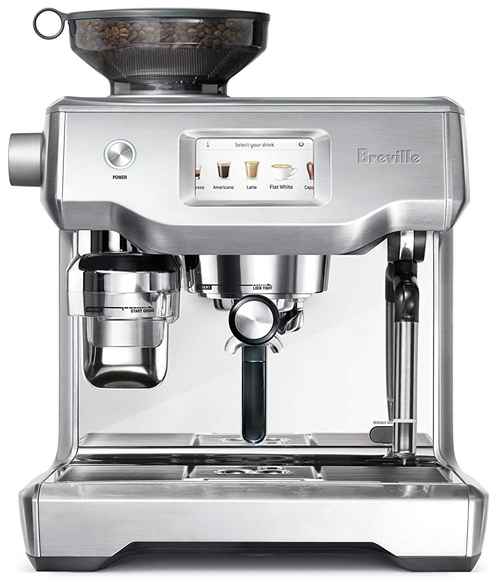Breville Latte Recipe [+Tips]
Note: This page contains affiliate links.
As an Amazon Associate, I earn from qualifying purchases when you click on the link, but you are not charged extra.
Ah, the latte-an iconic coffeehouse classic that has found its way into homes around the globe. But when you pair this beloved drink with the precision and craftsmanship of a Breville espresso machine, you’re entering a whole new realm of coffee artistry. Whether you’re a seasoned barista or a curious coffee enthusiast, making a latte with a Breville machine is a wonderful way to enjoy café-quality coffee right in your kitchen.
- Old World Christmas Beans: Tastes like the holidays in every cup — discover the cozy magic of Old World Christmas Beans before the season slips away.
- Kirkland Sumatra French Roast : Dark, bold, and wildly smooth—why Kirkland’s Sumatra French Roast is the best-kept secret of serious coffee drinkers.
- Hot Fudge Whole Bean Coffee : What happens when dessert meets coffee? Meet the decadent whole bean that tastes like hot fudge—but better.
- Aroma Ridge Guatemala Antigua Medium Roast : From the highlands of Guatemala to your morning mug—this rich, balanced roast is waking up coffee lovers everywhere.
- Juan Valdez Cumbre Colombian Coffee : Crafted by Colombia’s most iconic coffee legend—why Cumbre is a must-try for fans of bold, authentic flavor.
What makes the Breville latte so special? It’s the combination of freshly ground espresso, perfectly steamed milk, and that creamy, velvety texture only a great espresso machine can deliver. The Breville brand, known for its innovative technology and user-friendly design, makes the process seamless and fun. The result? A rich, balanced latte with deep espresso notes and smooth, frothy milk that dances on your palate.
In this guide, we’ll explore everything you need to know to craft the perfect Breville latte-from selecting ingredients to step-by-step instructions, pro tips, exciting variations, and a heartfelt conclusion. So, grab your favorite mug and let’s get brewing!
- 1 Ingredients For Breville Latte Recipe
- 2 How To Make Breville Latte?
- 3 Expert Tips
- 4 Recipe Variations
- 5 Final Words
- 6 FAQs
- 6.1 What Are The Basic Ingredients Needed For A Breville Latte Recipe?
- 6.2 How Do I Prepare Espresso Using A Breville Espresso Machine For My Latte?
- 6.3 What Type Of Milk Is Best For Making A Latte With A Breville Machine?
- 6.4 How Do I Steam Milk Properly Using A Breville Espresso Machine For A Latte?
- 6.5 What Is The Ideal Espresso To Milk Ratio For A Breville Latte Recipe?
- 6.6 Can I Make Flavored Lattes Using My Breville Machine? If Yes, How?
- 6.7 How Can I Clean The Breville Steam Wand After Making A Latte?
- 6.8 What Grind Size Should I Use For Espresso Beans When Making A Latte With A Breville Machine?
- 6.9 How Do I Adjust The Strength Of My Latte On A Breville Espresso Machine?
- 6.10 Are There Any Tips For Achieving Latte Art With A Breville Latte Recipe?
Ingredients For Breville Latte Recipe
The beauty of a latte lies in its simplicity, but quality matters. Here’s what you’ll need:
-
Fresh Espresso Beans
- Choose high-quality, freshly roasted espresso beans for the best flavor. Look for beans labeled ’espresso roast’ or a medium-dark roast with rich chocolatey, nutty, or caramel notes.
- Whole beans are preferred because grinding just before brewing preserves flavor and aroma.
-
Filtered Water
- Always use fresh, filtered water in your Breville machine to avoid off-flavors and protect the machine from mineral build-up.
-
Milk
- Whole milk is classic for its creaminess and ability to froth beautifully.
- Alternatives: oat milk, almond milk, soy milk, or any milk alternative that steams well. (Note: Some plant milks may require experimentation for ideal frothing.)
-
Optional Sweeteners & Flavorings
- Vanilla syrup, caramel syrup, or simple sugar syrup if you like your latte sweetened.
- Cocoa powder or cinnamon for dusting on top.
How To Make Breville Latte?
Alright, let’s get down to the nitty-gritty! Making a latte with a Breville espresso machine is a delightful ritual, and here’s how to nail it every time:
-
Preheat Your Machine & Mug
- Turn on your Breville espresso machine and allow it to fully heat up (usually a few minutes).
- Preheat your mug with hot water to keep your latte warm longer.
-
Grind The Beans
- Use a burr grinder to grind your espresso beans to a fine consistency.
- The grind should be fine but not powdery – think table salt texture.
-
Prepare The Portafilter
- Add the ground espresso to the portafilter basket.
- Use a tamper to press the grounds evenly and firmly to create a smooth surface.
-
Pull The Espresso Shot
- Lock the portafilter into the machine.
- Start the extraction. Ideally, you want about 25-30 seconds for a perfect 1-1.5 oz espresso shot with a rich crema on top.
-
Steam The Milk
- Pour cold milk into a stainless steel frothing pitcher, filling it no more than halfway.
- Purge the steam wand briefly to remove condensation.
- Insert the steam wand just below the surface of the milk, angle it slightly, and turn on the steam.
- Stretch the milk by allowing air in for a few seconds, then submerge the wand deeper to create a whirlpool.
- Aim for velvety microfoam and a final milk temperature of around 140-150°F (60-65°C).
-
Combine Espresso And Milk
- Slowly pour the steamed milk over your espresso shot, holding back the foam with a spoon initially, then topping the drink with foam for that classic latte texture.
-
Optional Garnish
- Sprinkle cinnamon or cocoa powder on top, or drizzle a little syrup if desired.
Expert Tips
Want to elevate your latte game? Here are some insider nuggets:
- Use Fresh Beans: Beans start to lose flavor after grinding; grind just before brewing for peak freshness.
- Dial in Your Grind Size: If your espresso extracts too fast, go finer; too slow, go coarser. The sweet spot is key!
- Perfect Your Tamp Pressure: About 30 pounds of pressure creates an even puck for consistent extraction.
- Milk Temperature Matters: Don’t overheat milk-anything above 160°F can scorch and taste burnt.
- Practice Milk Frothing Techniques: The whirlpool motion is essential for silky microfoam. You want tiny, fine bubbles, not big frothy ones.
- Clean Your Machine: A clean steam wand and portafilter make a huge difference in taste and machine longevity. Purge steam wand after every use.
Recipe Variations
Lattes are wonderfully versatile-here are some exciting spins to try:
-
Vanilla Almond Latte
- Add a splash of vanilla syrup and use almond milk for a nutty, sweet flavor.
-
Mocha Latte
- Mix in a spoonful of chocolate syrup with the espresso before adding steamed milk for a chocolaty delight.
-
Spiced Chai Latte
- Replace espresso with brewed chai tea and steam milk the same way for a cozy, spicy twist.
-
Iced Breville Latte
- Brew the espresso, pour over ice, and add cold steamed milk or milk froth for a refreshing version.
-
Matcha Latte
- Swap espresso for matcha powder whisked in hot water, topped with steamed milk.
Final Words
Making a latte with your Breville espresso machine is not just about the end product-it’s a sensory experience. The aroma of freshly ground coffee, the sound of steaming milk, the sight of silky foam, and the satisfying taste of that first sip all come together to make your coffee ritual something truly special.
Don’t be discouraged if your first few attempts aren’t perfect. Like any craft, it takes practice and patience. Experiment with grind sizes, milk types, and temperatures until you discover your personal latte nirvana. And remember, the joy is in the journey just as much as the destination!
FAQs
What Are The Basic Ingredients Needed For A Breville Latte Recipe?
The basic ingredients for a Breville latte include fresh espresso coffee beans, filtered water, and cold milk. Optionally, you can add sweeteners or flavored syrups according to taste.
How Do I Prepare Espresso Using A Breville Espresso Machine For My Latte?
To prepare espresso on a Breville machine, first grind your coffee beans to a fine consistency, then tamp the coffee evenly into the portafilter. Lock the portafilter into the machine, select the espresso shot size (usually a single or double shot), and start the extraction. The machine will force hot water through the coffee grounds to produce a rich espresso shot.
What Type Of Milk Is Best For Making A Latte With A Breville Machine?
Whole milk is generally recommended for lattes because it creates a creamy texture and thick microfoam. However, you can also use alternatives such as skim milk, oat milk, almond milk, or soy milk depending on dietary preferences.
How Do I Steam Milk Properly Using A Breville Espresso Machine For A Latte?
Use the steam wand to froth cold milk by submerging the tip just below the surface of the milk and turning on the steam. Keep the milk moving in a whirlpool motion to create smooth, velvety microfoam. Heat the milk to around 140-150°F (60-65°C) for optimal texture and taste.
What Is The Ideal Espresso To Milk Ratio For A Breville Latte Recipe?
A traditional latte consists of about one part espresso to three parts steamed milk. Typically, this means using a 1-2 ounce espresso shot combined with 6-8 ounces of steamed milk.
Can I Make Flavored Lattes Using My Breville Machine? If Yes, How?
Yes, you can add flavored syrups such as vanilla, caramel, or hazelnut to your latte. Simply add the syrup to the cup before pouring the steamed milk and espresso, then stir to combine evenly.
How Can I Clean The Breville Steam Wand After Making A Latte?
Immediately after steaming milk, wipe the steam wand with a damp cloth to remove milk residue. Then purge the steam wand by briefly turning on the steam to expel any milk inside. Regular deep cleaning includes soaking the wand tip in warm water and using a cleaning tool if available.
What Grind Size Should I Use For Espresso Beans When Making A Latte With A Breville Machine?
For espresso on a Breville machine, a fine grind size is recommended. The grind should be finer than drip coffee but not too fine to cause over-extraction or clogging.
How Do I Adjust The Strength Of My Latte On A Breville Espresso Machine?
You can adjust the strength by changing the amount of coffee grounds used, adjusting the grind size to control extraction time, or modifying the shot volume (single vs. double). Using a finer grind and more coffee typically results in a stronger espresso base.
Are There Any Tips For Achieving Latte Art With A Breville Latte Recipe?
To create latte art, steam milk to create smooth microfoam with no large bubbles. Pour the steamed milk slowly and steadily into the espresso at the right height, then move the pitcher closer to the cup to create patterns. Practice controlling pour speed and milk texture for the best results.

